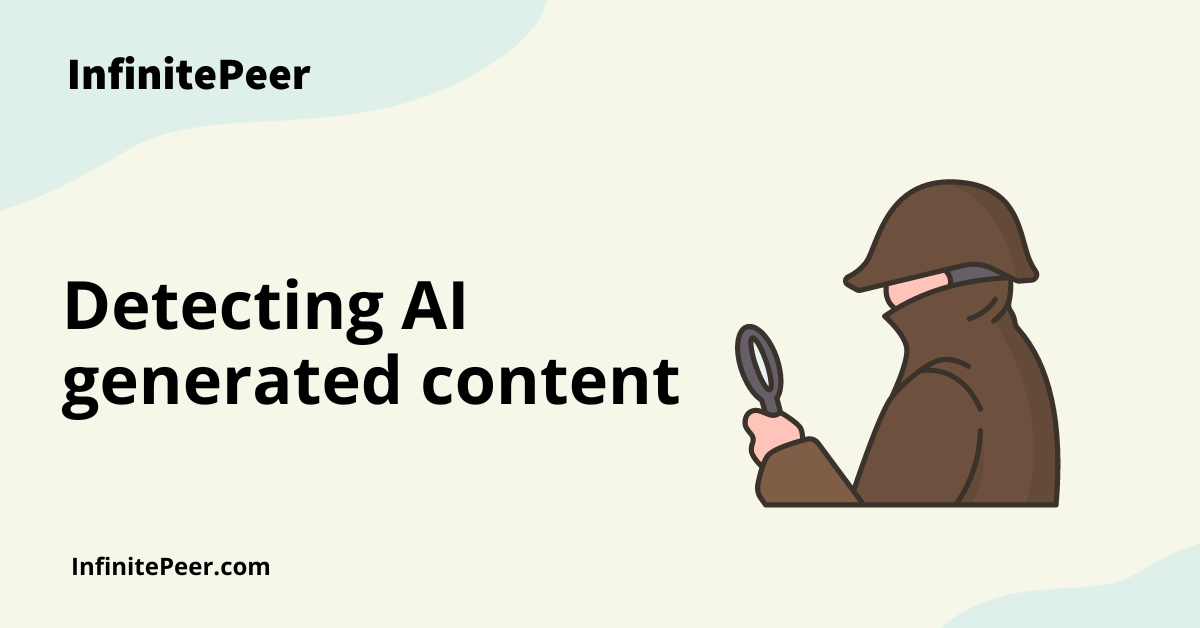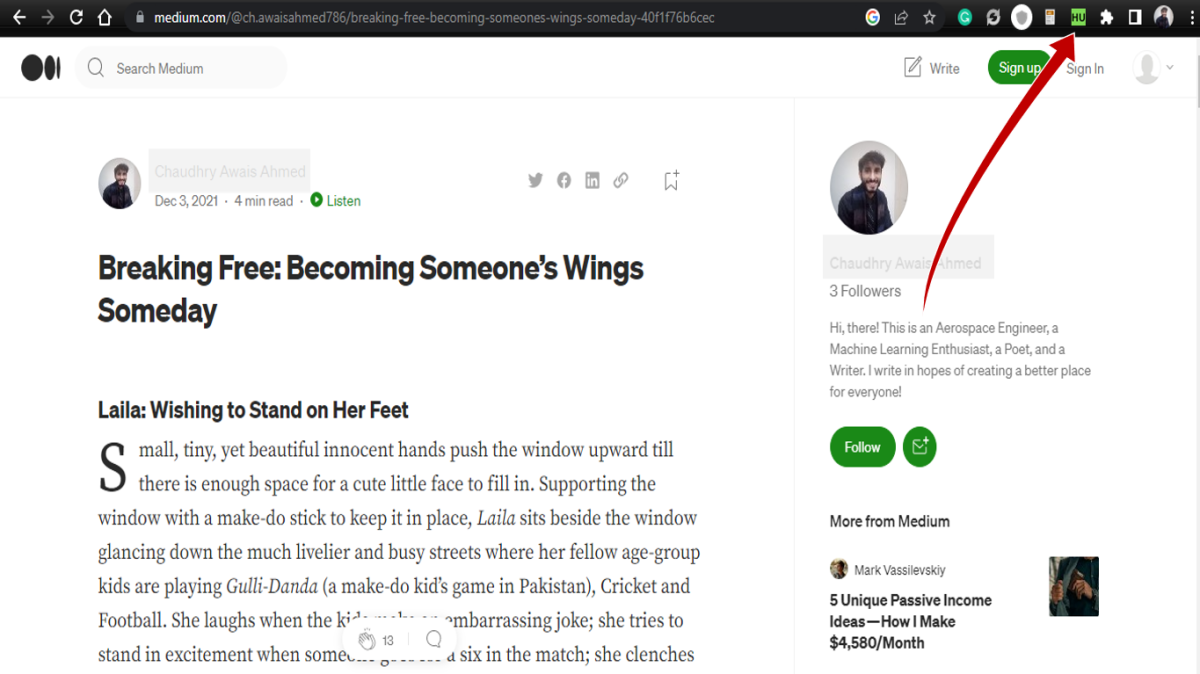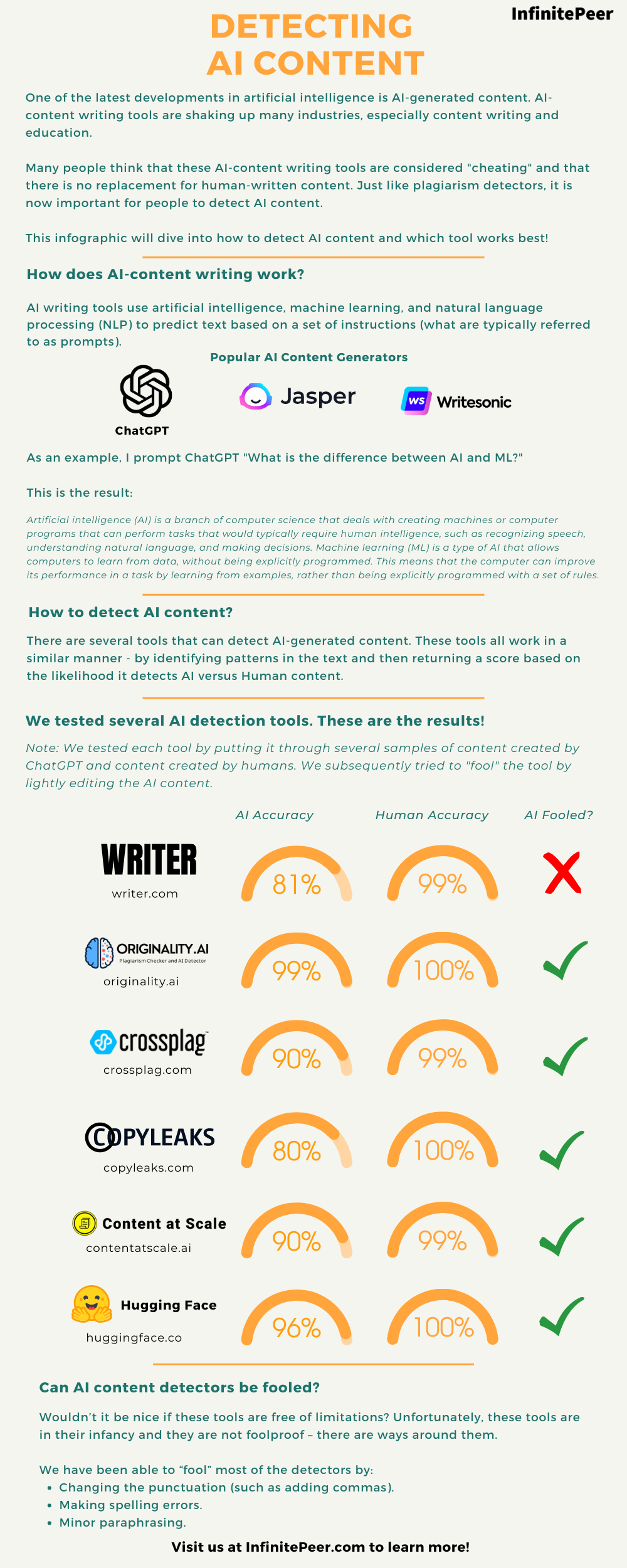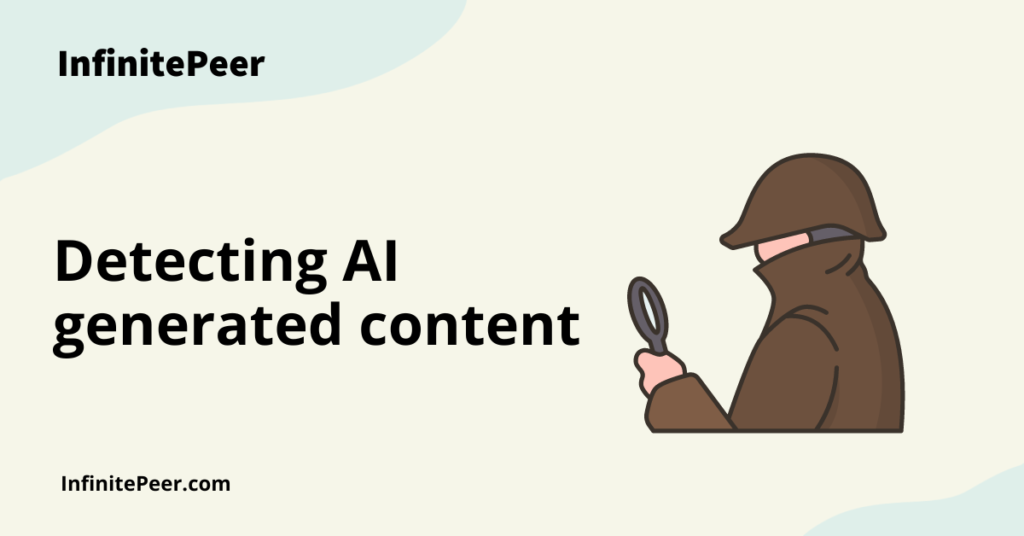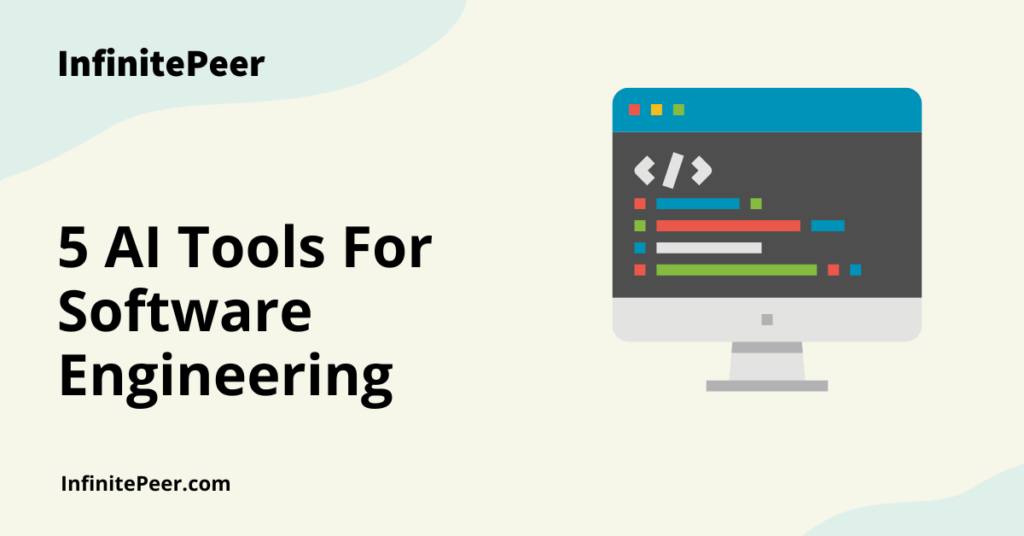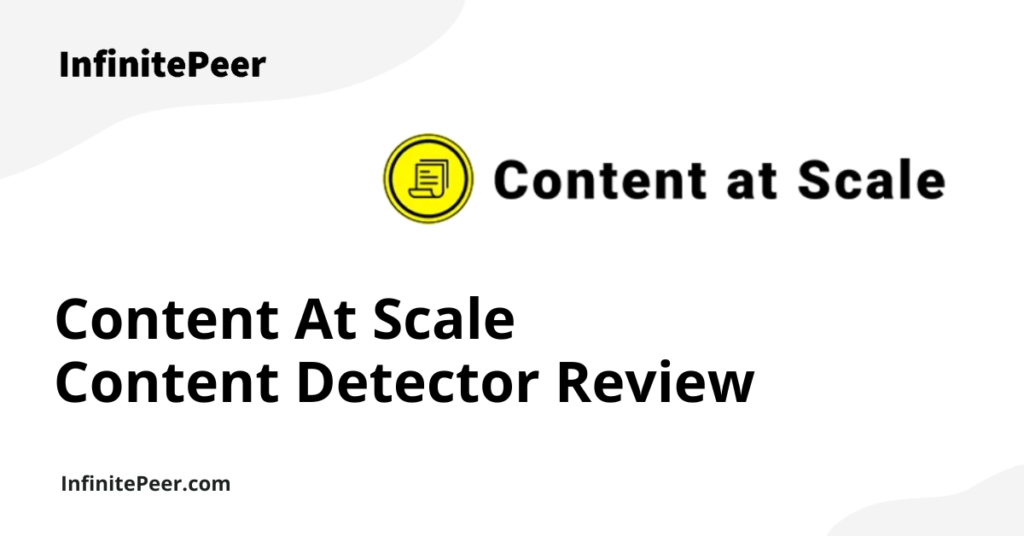This post was updated on February 19, 2023 with the results of our latest tests.
Whenever you open up your laptop or scroll through your news feed, something new is happening in the world of AI these days. One of the latest developments is AI-generated content writing. Content writers are one of the first groups of people diving into these AI-content writing tools. Though these tools are not only shaking up content writing, they are having a wide impact on many industries.
On one hand, students are using these tools to “cheat” on their assignments or exams, and on the other, educators are looking to crack down on this content.
So, let’s dive into what AI-generated content is, why people are worried about it and how we can detect AI content?
What is “AI-Generated Content”?
AI-generated content is a text created by a machine, an artificial bot. You prompt the AI tool with keywords and phrases, and it uses the algorithms and billions of documents they were trained on to spin up a piece of relevant content. You can use AI writing tools to write blog posts, landing page copy, articles, quotes, business plans, presentations, and emails—the options are endless!
Why are teachers, professors, writers, and bloggers worried about AI-generated content?
Education and content creation seem to be the two fields most worried about AI-made content.
These writing tools can help students write essays, but the problem is what the essays are used for and how they are used. Students who use AI writing assistants to draft academic content compromise academic integrity and fail to meet originality standards.
This is exactly why professors and teachers are worried about the latest AI tools (especially Chat-GPT) and discourage their use. Many universities and school boards are already taking strict action; for example, NYC public schools have already banned Chat GPT for students and teachers alike. First it was plagiarism, and next it will be AI-content creation.
But things are different when it comes to people who make content for a living. This artificial intelligence trend impacts them in multiple ways:
- Tools can be used as assistants to help make the production of high-quality content faster and more efficient;
- Tools can also be used to develop sub-par content, making it difficult for those who employ content creators weary; and
- Google is cracking down on AI-generated content, upping the bar for content creators in terms of the quality and originality of content expected to rank well.
That said, if your website has original content written by a human, then there is little to worry about.
Content creators and students who use ChatGPT or other writing tools as their only source of writing do need to worry (or change their strategies) because there are tools that can instantly spot AI-generated content.
Who needs AI content detectors?
If you are in any of these roles or professions, this next section is for you:
- Teacher, professor, or educator: Just as you are using plagiarism checkers to ensure that students are not cheating, colleges and schools will soon require you to use these tools to verify academic submissions.
- Content agencies and content marketers: If you work with freelance writers and purchase content, these tools are a cheap way to ensure that the work you are receiving and paying for is legitimately produced.
- Website owners and website buyers: Given the crackdown on this type of mass-produced content and its impact on SEO, you want to ensure that your website or the websites you purchase are free of this content.
We’ll explain and show you how to detect artificial intelligence-generated content and what tools to leverage to do just that.
If you’re looking for a quick solution, read the next section. If you want a more complete solution, scroll down to where we’ve tested each tool to find out which one is the best.
How to Detect if Content is Created by AI?
So, you might be wondering if it’s possible to tell the difference between content written by AI and content written by humans.
One such tool is an easy-to-use Chrome extension, Detect GPT. This is a highly flexible tool that works automatically, on the fly.
Let’s dive into how to use it.
Detecting AI-Generated Content with a Chrome Extension: Detect GPT
Detect GPT is a highly flexible Chrome extension that is free to install. Just go to the Detect GPT Extension and hit the “add to Chrome” button.
Wait for the installation, and once complete, open a new Chrome tab. Go to Chrome settings and select “Extensions” or just click the jigsaw puzzle piece to manage your extensions. Pin the newly added extension, extension, “Detect GPT”, so that it shows in the top right corner. Once done setting up this extension, test it out on any website.
On a new website, click the Detect GPT extension, which will show you whether the page contains AI content.
For pages with not much content, you can manually copy and paste the page content into the dialogue box to see how much of it was made by humans. Take a look at the image below for an example.
This is a page from a blogger’s website on Medium. Let’s check whether the content is original. Click the small “Detect GPT” extension as shown in the image above. This opens up the dialogue box showing you the results.
Indeed, the content is original. And this only took seconds to analyze!
Which AI Content Detector Works Best?
The following infographic summarizes the result of our testing. Read below for a methodology and detailed results.
The Methodology
If you need a more comprehensive solution to check both webpages and other types of documents, there are now several options to choose from, both free and paid.
We standardized an AI versus Human content test, which we applied across all tools so that we can truly see which one is most effective.
Our test consisted of:
- We used ChatGPT and inputted three different types of prompts. Each prompt provided us with a response, which we know to be AI-generated.
- We used three human-written pieces of content, two from our website and one from the web (this Forbes article).
- We attempted to “fool” the detector by making a few changes to the ChatGPT-generated text (further described in the limitations section below).
We found that this is the proper way to standardize comparisons from one tool to the next. To achieve a perfect score, the ChatGPT content must be labeled as 100% AI, while the human-written content is 100% human (or 0% AI)!
We put the following tools to the test (refer to each individual review):
- Crossplag
- Copyleaks
- Originality.AI
- Content at Scale
- Hugging Face GPT-2 Output Detector
- Writer
The Results
The following table summarizes the results of the test.
| Tool | Features | AI-Written Test Results | Human-Written Test Results | Fooled? | Price |
|---|---|---|---|---|---|
| Crossplag | - Plagiarism checker - Unique workflows | 1) 100% 2) 71% 3) 100% | 1) 99% 2) 98% 3) 99% | Yes | $9.99 for 5,000 words $149.99 for 100,000 words |
| Copyleaks | - Plagiarism checker - Five languages - LMS integration - Chrome extension | 1) 100% 2) Failed 3) 100% | 1) 100% 2) 100% 3) 100% | Yes | $10.99/month for 25,000 words $24.99/month for 62,500 words |
| Originality.AI | - Proprietary algoritm - API integration - Team management - Chrome extension | 1) 99% 2) 98% 3) 99% | 1) 100% 2) 95% 3) 93% | Yes | $20 for 200,000 words |
| Content at Scale | - One language (English) - API integration (with permission) | 1) 100% 2) 76% 3) 100% | 1) 100% 2) 99% 3) 100% | Yes | Free |
| Hugging Face GPT-2 Detector | - Free - Easy to use | 1) 98.71% 2) 89.43% 3) 99.98% | 1) 99.98% 2) 99.87% 3) 99.97% | Yes | Free |
| Writer | - API | 1) 92% 2) 94% 3) 56% | 1) 100% 2) 96% 3) 100% | No | Free |
What are the limitations of AI content detectors?
Wouldn’t it be nice if these tools are free of limitations? Unfortunately, these tools are in their infancy and they are not foolproof – there are ways around them.
As mentioned, we attempted to “fool” each of the detectors. We did this by:
- Changing the punctuation. We added a few commas.
- Making two spelling errors.
- Paraphrasing two sentences.
As you can see from the results, the majority of the content detectors were fooled. If you are wondering how to beat GPT detectors, there’s your answer. Unfortunately, this means that students and writers can somewhat easily beat these detectors. This brings into question a major question: would you consider content to be AI-written if it was edited by a real human?
How has Google responded to AI-generated Content?
As AI-made content slowly takes over the internet, originality standards seem to be dropping. Once the shiny, newness of AI-generated text wears off, humans will continue to crave real, original thoughts from real people instead of bots.
Of course, as the world’s leading search engine and a major source of information for most of the globe, Google has responded to the flood of AI-written content. Google has recently released several updates that prioritize human-generated content in their SEO rankings.
Again, those of us who write original content and have original opinions have nothing to worry about.
Those of us using AI to help us write higher-quality content, brainstorm more ideas, and be more efficient in our work also have nothing to worry about!
A word to the wise: if you are relying 100% on AI content, don’t! Your customers, your teachers, or Google will quickly catch on and penalize you for it.
